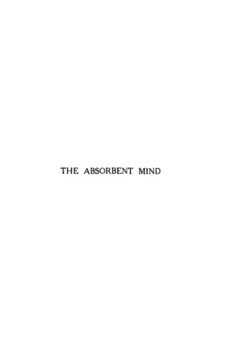Table Of ContentTHE ABSORBENT MIND
THE
\
ABSORBENT
\ |
MIND
by
Maria Montcssori
M.D., D.Litt., F.E.I.S
1949
THE THEOSOPHICAL PUBLISHING HOUSE
ADYAfi MADRAS INDIA
INTRODUCTION
THE present volume is based upon the lectures given by
Dr. Maria Montessori at Ahmedabad, during the first
Training Course after her internment in India which
lasted up to the end of World War II. In it she exposes
the unique mental powers of the young child which
enable him to construct and firmly establish within a few
years only, without teachers, without any of the usual
aids of education, nay, almost abandoned and often
obstructed, all the characteristics of the human per^bnal-
ity. This achievement by a being, weak in its physical
powers, who is born with great potentialities, but prac-
tically without any of the actual factors of mental life, a
being who may be called a zero, but who after only
six years already surpasses all other living beings, is
indeed one of the greatest mysteries of life. In the present
volume Dr. Montessori not only sheds the light of her
penetrating insight, based on close observation and just
appreciation, on the phenomena of this earliest and yet
most decisive period of human life, but also indicates the
responsibility of adult humanity towards it. She, indeed,
gives a practical meaning to the now universally accepted
"
necessity of education from birth ". This can be given,
" "
only, when education becomes a help to life and
VI
transcends the narrow limits of teaching and direct
transmission of knowledge or ideals from one mind to
another. One of the best known principles of the
"
Montessori Method is the preparation of the environ-
"
ment at this stage of life, long before the child enters
;
a school, this principle provides the key to the realization
of an education from birth, to a real cultivation of a
human individual from its very beginning. This is a plea
made on scientific foundations, but it is the plea also of
one who has witnessed and helped the manifestations of
child-nature all over the world, manifestations of mental
and spiritual grandeur, which form a startling contrast to
the picture shown by mankind which, abandoned during
its formative period, grows up as the greatest menace to
own
its survival.
MARIO M. MONTESSORI
Karachi, May 1949.
CONTENTS
CHAPTER PAGE
Introduction v
. . .
~ The Child and World Reconstruction
I. . ..101
II. Education for Life . . .
.24
III. The Periods of Growth . .
A New .41
IV. Orientation
. .
.57
V. The Miracle of Creation
. .
.74
One Plan, One Method
. .
.91
VI. Man's Universality
. . .
VII. The Psycho-embryonic Life .107
. .
VIII. The Conquest of Independence .122
.
IX. Care to be taken at Life's Beginning . 138
X. On Language .157
. . .
XI. The Call of Language .169
. .
XII. Obstacles and their Consequences .184
.
XIII. Movement and Total Development .198
.
XIV. Intelligence and the Hand . . .212
XV. Development and Imitation 224
. . .
XVI. From Unconscious Creator to Conscious Worker 235
.
XVII. The New Teacher .247
. .
XVIII. Further Elaboration through Culture and Imagi-
nation .... .. ..261
XIX. Character and its Defects in Young Children 276
.
XX. A Social Contribution of the Child Normal-
:
ization. 288
XXI. Character-building a Conquest, not a Defence 302
.
XXII. The Sublimation of Possessiveness .315
.
Vlll
CHAPTER PAGE
XXIII. Social Development 325
XXIV. Society by Cohesion 342
XXV. Error and its Control 363
XXVI. The Three Degrees of Obedience 375
XXVII. The Montessori Teacher 393
XXVIII. The Fountain Source of Love the Child 409
:
LIST OF ILLUSTRATIONS
PAGE
Dr. Maria Montessori Frontispiece
The Multiplication of the Germinal Cell . 49
A
Chain of 100 Genes 60
.
Primitive Ball and Walls of Cells 65
. .
Points of Sensitivity . 66
Types of Cells 68
.
Embryonic Forms 75
.
New Born Child and Adult brought to the same seal 114
The Cerebellum at the base of the brain 128
.
Diagram. Tendencies towards Independence facing 136
Development of Language facing 184
....
Grammar Symbols facing ]86
Schematic diagram of the Development of
Language facing 196
....
Development of Movement facing 212
Normal and deviated features of the child's
....
Character facing 291
Circles of attraction towards superior and
360
inferior types facing

